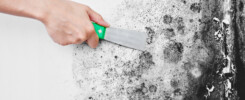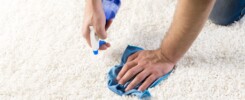Did you know that there are over 100,000 different types of mold?
EPA scientists created the Environmental Relative Moldiness Index (ERMI) as a research tool for calculating mold contamination. Researchers use the index to calculate the quantity and types of mold that are present in a property.
Do you want to learn more about ERMI testing? If so, you’ve come to the right place. Below, we share everything you need to know about the Environmental Relative Moldiness Index.
What Is Mold?
Molds are tiny organisms that are found practically everywhere—indoors and out. They’re most often found on food, plants, and dry leaves. Molds are necessary to decompose dead matter and are advantageous to the environment.
Mold spores are small and lightweight, often airborne. Large populations of molds may produce allergic reactions. These reactions resemble those brought on by plant pollen.
Molds proliferate by dispersing microscopic spores, which are airborne and undetectable to the naked eye. When mold spores touch damp surfaces, mold growth may start within. All varieties of mold cannot grow without moisture or water.
Indoor molds are typically not a concern until they land in a damp area and start proliferating. Once they start to grow, it’s possible that mold may harm human health.
Where Does Mold Typically Grow?
In homes and buildings, mold is a very prevalent problem. Mold will develop in damp, moisture-rich parts of the home. These places include piping and windows. If there’s been a roof leak, it’s likely that mold is encouraged to grow there as well.
The same case goes for areas that have been recently flooded. The extra moisture serves as the perfect breeding ground for mold.
Mold also thrives in other places. You might find mold growing on cardboard, paper products, on the ceiling, and even on wood. In addition, mold grows on:
- Dust
- Paint
- Wallpaper
- Insulation
- Drywall
- Carpet
- Textiles
Cladosporium, Penicillium, and Aspergillus are the most prevalent indoor mold species. However, the frequency with which various molds are discovered in homes and buildings is unknown.
Both indoors and outside, mold may grow. Open doors, windows, vents, and heating and cooling systems allow mold to infiltrate your home. Mold in the outdoor air also adheres to items of clothes, footwear, and animals and is brought inside.
Moist, damp areas encourage mold growth. These areas include near pipes and roofs or where there has been a leak or any flooding.
Molds also love to grow on wet materials like cardboard. Unfortunately, it doesn’t stop here. Mold also loves to make its home in cardboard, ceilings, and other paper products. Mold even grows on wood, which means that wood on houses is especially vulnerable.
How Does ERMI Work?
One dust sample from a property is examined as part of the ERMI test.
Mold-specific quantitative polymerase chain reaction (MSQPCR) is used to evaluate the sample. The Environmental Relative Moldiness Index, or ERMI, is a score. This score is created by dividing the number of species associated with water damage by the number of typical indoor molds.
Usually, the ERMI value ranges from -10 to 20. The ERMI must get compared to a national database to use this new instrument as efficiently as possible.
Various metrics were combined to form the Relative Moldiness Index (RMI) Scale, graded nationally from lowest to highest.
Advantages of ERMI Testing
This technology has several advantages compared to the conventional methods of spore counting and growing. The principal benefits include:
- Rapid turnaround time
- Precise fungal identification and detection
- Reproducible outcomes detection of fungi and fungal spores, regardless of viability
- Exceptional sensitivity to quantity
- Excellent sensitivity to detection
In situations like culturable air samples and spore trap samples, PCR technology also enables sampling over an extended period, minimizing the drawbacks of grab sampling. However, caution is advised when conducting PCR sampling and testing.
In contrast to short-term air samples, carpet dust serves as a reservoir for mold spores and is a better indicator of mold levels over time. Since MSQPCR is based on a biochemical assay using calibrated equipment, it gets used for this test with greater precision.
Testing for Mold Contamination
What should you do if you suspect mold contamination in your home or commercial building?
Mold testing is exceedingly challenging and expensive, and it doesn’t predict whether adverse health effects will emerge. Mold is typically found outside; the season affects how many there are each day.
In most circumstances, testing for mold is not advised due to the uncertainty involved. It needs to get cleaned up if mold is visible or odorous.
Humidifiers, poorly ventilated regions, flooding, a damp basement or crawl space, leaking plumbing, or clothes dryers are a few examples of sources of moisture in a home.
Mold needs to get cleaned up if you see or smell it. The underlying issue must also be resolved to stop the mold from spreading once more.
Before cleaning up mold, it’s crucial to ensure all moisture sources are gone. Mold will start to grow once again if this is not done. An expert in mold remediation should be in charge of cleaning up the area if the mold growth is more than 10 square feet.
In most circumstances, you may complete the task alone if the space is smaller than 10 square feet.
Getting Rid of Mold
There will always be mold spores in the air and household dust. Thus, it is difficult to eradicate mold and mold spores indoors completely. However, without moisture, the mold spores won’t increase.
Controlling indoor moisture should stop or slow down indoor mold growth. If you notice mold growing in your home, you must remove it and address the water issue. Most likely, the mold issue will return if you remove the mold but don’t address the water issue.
It’s challenging to keep areas that are frequently or constantly damp fully mold-free. Increasing ventilation and cleaning more frequently will typically stop mold from returning, or at least keep it to a minimum if there is any mold in the shower or other areas of the bathroom that seems to resurface.
Mold removal gets done using several ordinary household products. Wearing rubber gloves while using cleaning goods will safeguard your hands.
For hard surfaces in bathrooms and kitchens, use white vinegar undiluted.
To kill mold, you may also use a bleach solution. Don’t rinse after applying one cup of bleach and one gallon of water to the surface.
Ammonia and water shouldn’t get combined 50/50. Apply a spray, let it sit for two to three hours, and then rinse.
Ammonia should never get combined with bleach or other all-purpose cleaners, resulting in hazardous and toxic emissions.
Are you hiring a contractor? Make sure the contractor has experience cleaning up the mold if you decide to engage one (or another professional service provider) to handle the cleanup. Verify the contractor’s references and request that they follow the advice in the EPA’s Mold Remediation in Schools and Commercial Buildings.
Dangers of Mold to Human Health
When exposed to mold, water damage, germs, viruses, and allergies that are present indoors, people may have health issues. Mold, indoor allergies, germs, and viruses might affect some people more severely than others.
Mold exposure and poor indoor air quality may result in symptoms including a stuffy nose, itchy eyes, fever, headaches, skin irritation, and more.
Individuals with weakened immune systems, recurrent diseases, underlying medical conditions, asthma, small children, and the elderly are at risk. However, exposure to mold, water damage, germs, viruses, and poor indoor air quality may result in health issues for everyone.
Mold-related illnesses are more likely to affect those who live or work in wet, inadequately ventilated facilities.
A person’s sensitivity may rise with repeated contact with mold, leading to increasingly severe allergic reactions. Indoor air quality issues caused by mold make these issues worse.
Mycotoxins are toxins that some molds, such as Stachybotrys and Aspergillus, have the ability to create under specific circumstances. Mycotoxins may result in more severe sickness.
Our clients work closely with Big Easy Restoration’s staff to ensure their safety. We help them understand the risks and concerns associated with exposure to mold, water damage, and poor indoor air quality.
Learn About ERMI Testing and Its Benefits
The Environmental Relative Moldiness Index (ERMI), developed by EPA scientists, is a research technique for estimating mold contamination. It has many benefits, including protecting human health and improving the indoor environment.
To check out our high-quality mold remediation services, click this link.


